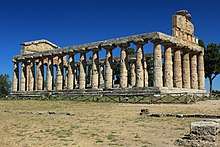Ancient Greek religion
| Part of a series on | ||||||
| Ancient Greek religion | ||||||
|---|---|---|---|---|---|---|
 | ||||||
|
Godheads
|
||||||
|
Ethics |
||||||
|
Practices |
||||||
|
| ||||||
Ancient Greek religion encompasses the collection of beliefs, rituals, and mythology originating in ancient Greece in the form of both popular public religion and cult practices. These groups varied enough for it to be possible to speak of Greek religions or "cults" in the plural, though most of them shared similarities.
Most ancient Greeks recognized the twelve major Olympian gods and goddesses: (Zeus, Hera, Poseidon, Demeter, Athena, Ares, Aphrodite, Apollo, Artemis, Hephaestus, Hermes, and either Hestia or Dionysus), although philosophies such as Stoicism and some forms of Platonism used language that seems to assume a single transcendent deity. The worship of these deities, and several others, was found across the Greek world, though they often have different epithets that distinguished aspects of the deity, and often reflect the absorption of other local deities into the pan-Hellenic scheme.
The religious practices of the Greeks extended beyond mainland Greece, to the islands and coasts of Ionia in Asia Minor, to Magna Graecia (Sicily and southern Italy), and to scattered Greek colonies in the Western Mediterranean, such as Massalia (Marseille). Early Italian religions such as the Etruscan were influenced by Greek religion in forming much of the ancient Roman religion.
Beliefs
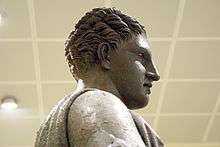
While there were few concepts universal to all the Greek peoples, there were common beliefs shared by many.
Theology
Ancient Greek theology was polytheistic, based on the assumption that there were many gods and goddesses, as well as a range of lesser supernatural beings of various types. There was a hierarchy of deities, with Zeus, the king of the gods, having a level of control over all the others, although he was not almighty. Some deities had dominion over certain aspects of nature. For instance, Zeus was the sky-god, sending thunder and lightning, Poseidon ruled over the sea and earthquakes, Hades projected his remarkable power throughout the realms of death and the Underworld, and Helios controlled the sun. Other deities ruled over abstract concepts; for instance Aphrodite controlled love. All significant deities were visualized as "human" in form, although often able to transform themselves into animals or natural phenomena.[1]
While being immortal, the gods were certainly not all-good or even all-powerful. They had to obey fate, known to Greek mythology as the Moirai,[2] which overrode any of their divine powers or wills. For instance, in mythology, it was Odysseus' fate to return home to Ithaca after the Trojan War, and the gods could only lengthen his journey and make it harder for him, but they could not stop him.
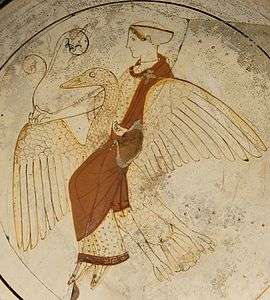
The gods acted like humans and had human vices.[3] They would interact with humans, sometimes even spawning children with them. At times certain gods would be opposed to others, and they would try to outdo each other. In the Iliad, Aphrodite, Ares and Apollo support the Trojan side in the Trojan War, while Hera, Athena and Poseidon support the Greeks (see theomachy).
Some gods were specifically associated with a certain city. Athena was associated with the city of Athens, Apollo with Delphi and Delos, Zeus with Olympia and Aphrodite with Corinth. But other gods were also worshipped in these cities. Other deities were associated with nations outside of Greece; Poseidon was associated with Ethiopia and Troy, and Ares with Thrace.
Identity of names was not a guarantee of a similar cultus; the Greeks themselves were well aware that the Artemis worshipped at Sparta, the virgin huntress, was a very different deity from the Artemis who was a many-breasted fertility goddess at Ephesus. Though the worship of the major deities spread from one locality to another, and though most larger cities boasted temples to several major gods, the identification of different gods with different places remained strong to the end.
Afterlife
The Greeks believed in an underworld where the spirits of the dead went after death. One of the most widespread areas of this underworld was ruled over by Hades, a brother of Zeus, and was known as Hades (originally called 'the place of Hades'). Other well known realms are Tartarus, a place of torment for the damned, and Elysium, a place of pleasures for the virtuous. In the early Mycenean religion all the dead went to Hades, but the rise of mystery cults in the Archaic age led to the development of places such as Tartarus and Elysium.
A few Greeks, like Achilles, Alcmene, Amphiaraus Ganymede, Ino, Melicertes, Menelaus, Peleus, and a great number of those who fought in the Trojan and Theban wars, were considered to have been physically immortalized and brought to live forever in either Elysium, the Islands of the Blessed, heaven, the ocean, or beneath the ground. Such beliefs are found in the most ancient of Greek sources, such as Homer and Hesiod. This belief remained strong even into the Christian era. For most people at the moment of death there was, however, no hope of anything but continued existence as a disembodied soul.[4]
Some Greeks, such as the philosophers Pythagoras and Plato, also embraced the idea of reincarnation, though this was only accepted by a few. Epicurus taught that the soul was simply atoms which dissolved at death, so there was no existence after death.
Mythology
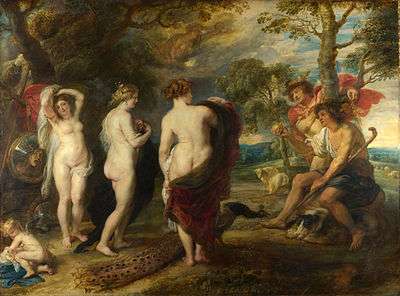
Greek religion had an extensive mythology. It consisted largely of stories of the gods and how they interacted with humans. Myths often revolved around heroes and their actions, such as Heracles and his twelve labors, Odysseus and his voyage home, Jason and the quest for the Golden Fleece and Theseus and the Minotaur.
Many species existed in Greek mythology. Chief among these were the gods and humans, though the Titans (who predated the Olympian gods) also frequently appeared in Greek myths. Lesser species included the half-man-half-horse centaurs, the nature based nymphs (tree nymphs were dryads, sea nymphs were Nereids) and the half man, half goat satyrs. Some creatures in Greek mythology were monstrous, such as the one-eyed giant Cyclopes, the sea beast Scylla, whirlpool Charybdis, Gorgons, and the half-man, half-bull Minotaur.
There was not a set Greek cosmogony, or creation myth. Different religious groups believed that the world had been created in different ways. One Greek creation myth was told in Hesiod's Theogony. It stated that at first there was only a primordial deity called Chaos, who gave birth to various other primordial gods, such as Gaia, Tartarus and Eros, who then gave birth to more gods, the Titans, who then gave birth to the first Olympians.
The mythology largely survived and was added to in order to form the later Roman mythology. The Greeks and Romans had been literate societies, and much mythology, although initially shared orally, was written down in the forms of epic poetry (such as the Iliad, the Odyssey and the Argonautica) and plays (such as Euripides' The Bacchae and Aristophanes' The Frogs). The mythology became popular in Christian post-Renaissance Europe, where it was often used as a basis for the works of artists like Botticelli, Michelangelo and Rubens.
Festivals
Various religious festivals were held in ancient Greece. Many were specific only to a particular deity or city-state. For example, the festival of Lykaia was celebrated in Arcadia in Greece, which was dedicated to the pastoral god Pan. Like the other Panhellenic Games, the ancient Olympic Games were a religious festival, held at the sanctuary of Zeus at Olympia. Other festivals centred on Greek theatre, of which the Dionysia in Athens was the most important. More typical festivals featured a procession, large sacrifices and a feast to eat the offerings, and many included entertainments and customs such as visiting friends, wearing fancy dress and unusual behaviour in the streets, sometimes risky for bystanders in various ways. Altogether the year in Athens included some 140 days that were religious festivals of some sort, though varying greatly in importance.
Morality
One of the most important moral concepts to the Greeks was the fear of committing hubris. Hubris constituted many things, from rape to desecration of a corpse,[5] and was a crime in the city-state of Athens. Although pride and vanity were not considered sins themselves, the Greeks emphasized moderation. Pride only became hubris when it went to extremes, like any other vice. The same was thought of eating and drinking. Anything done to excess was not considered proper. Ancient Greeks placed, for example, importance on athletics and intellect equally. In fact many of their competitions included both. Pride was not evil until it became all-consuming or hurtful to others.
Sacred texts
The Greeks had no religious texts they regarded as "revealed" scriptures of sacred origin, but very old texts including Homer's Iliad and Odyssey, and the Homeric hymns (regarded as later productions today), Hesiod's Theogony and Works and Days, and Pindar's Odes were regarded as having authority[6] and perhaps being inspired; they usually begin with an invocation to the Muses for inspiration. Plato even wanted to exclude the myths from his ideal state described in the Republic because of their low moral tone.
While some traditions, such as Mystery cults, did uphold certain texts as canonic within their own cult praxis, such texts were respected but not necessarily accepted as canonic outside their circle. In this field, of particular importance are certain texts referring to Orphic cults: multiple copies, ranging from 450 BC to 250 AD, have been found in various locations of the Greek world. Even the words of the oracles never turned into a sacred text. Other texts were specially composed for religious events, and some have survived within the lyric tradition; although they had a cult function, they were bound to performance and never developed into a common, standard prayer form comparable to the Christian Pater Noster. An exception to this rule were the already named Orphic and Mystery rituals, which, in this, set themselves aside from the rest of the Greek religious system. Finally, some texts called hieroi logoi (Greek: ιεροί λόγοι) (sacred texts) by the ancient sources, originated from outside the Greek world, or were supposedly adopted in remote times, representing yet more different traditions within the Greek belief system.
Practices
Ceremonies
The lack of a unified priestly class meant that a unified, canonic form of the religious texts or practices never existed; just as there was no unified, common sacred text for the Greek belief system, there was no standardization of practices. Instead, religious practices were organized on local levels, with priests normally being magistrates for the city or village, or gaining authority from one of the many sanctuaries. Some priestly functions, like the care for a particular local festival, could be given by tradition to a certain family. To a large extent, in the absence of "scriptural" sacred texts, religious practices derived their authority from tradition, and "every omission or deviation arouses deep anxiety and calls forth sanctions".[7]
Greek ceremonies and rituals were mainly performed at altars. These were typically devoted to one or a few gods, and supported a statue of the particular deity. Votive deposits would be left at the altar, such as food, drinks, as well as precious objects. Sometimes animal sacrifices would be performed here, with most of the flesh eaten, and the offal burnt as an offering to the gods. Libations, often of wine, would be offered to the gods as well, not only at shrines, but also in everyday life, such as during a symposium.
One ceremony was pharmakos, a ritual involving expelling a symbolic scapegoat such as a slave or an animal, from a city or village in a time of hardship. It was hoped that by casting out the ritual scapegoat, the hardship would go with it.
Sacrifice
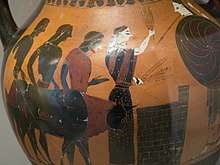
Worship in Greece typically consisted of sacrificing domestic animals at the altar with hymn and prayer. The altar was outside any temple building, and might not be associated with a temple at all. The animal, which should be perfect of its kind, is decorated with garlands and the like, and led in procession to the altar, a girl with a basket on her head containing the concealed knife leading the way. After various rituals the animal is slaughtered over the altar, as it falls all the women present "must cry out in high, shrill tones". Its blood is collected and poured over the altar. It is butchered on the spot and various internal organs, bones and other inedible parts burnt as the deity's portion of the offering, while the meat is removed to be prepared for the participants to eat; the leading figures tasting it on the spot. The temple usually kept the skin, to sell to tanners. That the humans got more use from the sacrifice than the deity had not escaped the Greeks, and is often the subject of humour in Greek comedy.[8]
The animals used are, in order of preference, bull or ox, cow, sheep (the most common), goat, pig (with piglet the cheapest mammal), and poultry (but rarely other birds or fish).[9] Horses and asses are seen on some vases in the Geometric style (900-750 BC), but are very rarely mentioned in literature; they were relatively late introductions to Greece, and it has been suggested that Greek preferences in this matter go very far back. The Greeks liked to believe that the animal was glad to be sacrificed, and interpreted various behaviours as showing this. Divination by examining parts of the sacrificed animal was much less important than in Roman or Etruscan religion, or Near Eastern religions, but was practiced, especially of the liver, and as part of the cult of Apollo. Generally, the Greeks put more faith in observing the behaviour of birds.[10] For a smaller and simpler offering, a grain of incense could be thrown on the sacred fire,[11] and outside the cities farmers made simple sacrificial gifts of plant produce as the "first fruits" were harvested.[12] The libation, a ritual pouring of fluid, was part of everyday life, and libations with a prayer were often made at home whenever wine was drunk, with just a part of the cup's contents, the rest being drunk. More formal ones might be made onto altars at temples, and other fluids such as olive oil and honey might be used. Although the grand form of sacrifice called the hecatomb (meaning 100 bulls) might in practice only involve a dozen or so, at large festivals the number of cattle sacrificed could run into the hundreds, and the numbers feasting on them well into the thousands.
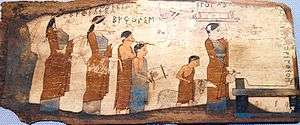
The evidence of the existence of such practices is clear in some ancient Greek literature, especially in Homer's epics. Throughout the poems, the use of the ritual is apparent at banquets where meat is served, in times of danger or before some important endeavor to gain the favor of the gods. For example, in Homer's Odyssey Eumaeus sacrifices a pig with prayer for his unrecognizable master Odysseus. However, in Homer's Iliad, which partly reflects very early Greek civilization, not every banquet of the princes begins with a sacrifice.[13]
These sacrificial practices share much with recorded forms of sacrificial rituals known from later. Furthermore, throughout the poem, special banquets are held whenever gods indicated their presence by some sign or success in war. Before setting out for Troy, this type of animal sacrifice is offered. Odysseus offers Zeus a sacrificial ram in vain. The occasions of sacrifice in Homer's epic poems may shed some light onto the view of the gods as members of society, rather than as external entities, indicating social ties. Sacrificial rituals played a major role in forming the relationship between humans and the divine.[14]
It has been suggested that the Chthonic deities, distinguished from Olympic deities by typically being offered the holocaust mode of sacrifice, where the offering is wholly burnt, may be remnants of the native Pre-Hellenic religion and that many of the Olympian deities may come from the Proto-Greeks who overran the southern part of the Balkan Peninsula in the late third millennium BC.[15]
Rites of passage
One rite of passage was the amphidromia, celebrated on the fifth or seventh day after the birth of a child. Childbirth was extremely significant to Athenians, especially if the baby was a boy.
Sanctuaries and temples
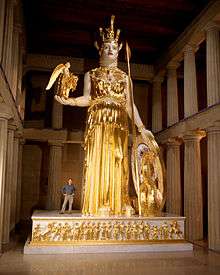
The main Greek temple building sat within a larger precinct or temenos, usually surrounded by a peribolos fence or wall; the whole is usually called a "sanctuary". The Acropolis of Athens is the most famous example, though this was apparently walled as a citadel before a temple was ever built there. The tenemos might include many subsidiary buildings, sacred groves or springs, animals dedicated to the deity, and sometimes people who had taken sanctuary from the law, which some temples offered, for example to runaway slaves.[16]
The earliest Greek sanctuaries probably lacked temple buildings, though our knowledge of these is limited, and the subject is controversial. A typical early sanctuary seems to have consisted of a tenemos, often around a sacred grove, cave or spring, and perhaps defined only by marker stones at intervals, with an altar for offerings. Many rural sanctuaries probably stayed in this style, but the more popular were gradually able to afford a building to house a cult image, especially in cities. This process was certainly under way by the 9th century, and probably started earlier.[17]
The temple interiors did not serve as meeting places, since the sacrifices and rituals dedicated to the respective deity took place outside them, at altars within the wider precinct of the sanctuary, which might be large. As the centuries past both the inside of popular temples and the area surrounding them accumulated statues and small shrines or other buildings as gifts, and military trophies, paintings and items in precious metals, effectively turning them into a type of museum.
Some sanctuaries offered oracles, people who were believed to receive divine inspiration in answering questions put by pilgrims. The most famous of these by far was the female priestess called the Pythia at the Temple of Apollo at Delphi, and that of Zeus at Dodona, but there were many others. Some dealt only with medical, agricultural or other specialized matters, and not all represented gods, like that of the hero Trophonius at Livadeia.
Cult images
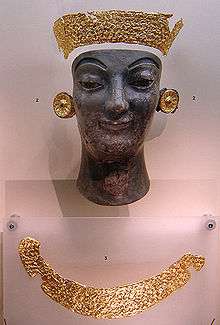
The temple was the house of the deity it was dedicated to, who in some sense resided in the cult image in the cella or main room inside, normally facing the only door. The cult image normally took the form of a statue of the deity, typically roughly life-size, but in some cases many times life-size. In early days these were in wood, marble or terracotta, or in the specially prestigious form of a chryselephantine statue using ivory plaques for the visible parts of the body and gold for the clothes, around a wooden framework. The most famous Greek cult images were of this type, including the Statue of Zeus at Olympia, and Phidias's Athena Parthenos in the Parthenon in Athens, both colossal statues, now completely lost. Fragments of two chryselephantine stutues from Delphi have been excavated. Bronze cult images were less frequent, at least until Hellenistic times.[18] Early images seem often to have been dressed in real clothes, and at all periods images might wear real jewellery donated by devotees.
The acrolith was another composite form, this time a cost-saving one with a wooden body. A xoanon was a primitive and symbolic wooden image, perhaps comparable to the Hindu lingam; many of these were retained and revered for their antiquity, even when a new statue was the main cult image. Xoana had the advantage that they were easy to carry in processions at festivals. Many of the Greek statues well known from Roman marble copies were originally temple cult images, which in some cases, such as the Apollo Barberini, can be credibly identified. A very few actual originals survive, for example, the bronze Piraeus Athena (2.35 m (7.7 ft) high, including a helmet). The image stood on a base, from the 5th century often carved with reliefs.
It used to be thought that access to the cella of a Greek temple was limited to the priests, and it was entered only rarely and by other visitors, except perhaps during important festivals or other special occasions. In recent decades this picture has changed, and scholars now stress the variety of local access rules. Pausanias was a gentlemanly traveller of the 2nd-century AD who declares that the special intention of his travels around Greece was to see cult images, and usually managed to do so.[19]
It was typically necessary to make a sacrifice or gift, and some temples restricted access either to certain days of the year, or by class, race, gender (with either men or women forbidden), or even more tightly. Garlic-eaters were forbidden in one temple, in another women unless they were virgins; restrictions typically arose from local ideas of ritual purity or a perceived whim of the deity. In some places visitors were asked to show they spoke Greek; elsewhere Dorians were not allowed entry. Some temples could only be viewed from the threshold. Some temples are said never to be opened at all. But generally Greeks, including slaves, had a reasonable expectation of being allowed into the cella. Once inside the cella it was possible to pray to or before the cult image, and sometimes to touch it; Cicero saw a bronze image of Heracles with its foot largely worn away by the touch of devotees.[20] Famous cult images such as the Statue of Zeus at Olympia functioned as significant visitor attractions.[21]
Mystery religions
Those who were not satisfied by the public cult of the gods could turn to various mystery religions which operated as cults into which members had to be initiated in order to learn their secrets.
Here, they could find religious consolations that traditional religion could not provide: a chance at mystical awakening, a systematic religious doctrine, a map to the afterlife, a communal worship, and a band of spiritual fellowship.
Some of these mysteries, like the mysteries of Eleusis and Samothrace, were ancient and local. Others were spread from place to place, like the mysteries of Dionysus. During the Hellenistic period and the Roman Empire, exotic mystery religions became widespread, not only in Greece, but all across the empire. Some of these were new creations, such as Mithras, while others had been practiced for hundreds of years before, like the Egyptian mysteries of Osiris.
History
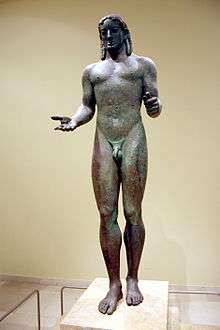
Origins
Mainstream Greek religion appears to have developed out of Proto-Indo-European religion and although very little is known about the earliest periods there are suggestive hints that some local elements go back even further than the Bronze Age or Helladic period to the farmers of Neolithic Greece. There was also clearly cultural evolution from the Late Helladic Mycenaean religion of the Mycenaean civilization. Both the literary settings of some important myths and many important sanctuaries relate to locations that were important Helladic centres that had become otherwise unimportant by Greek times.[22]
The Mycenaeans perhaps treated Poseidon, to them a god of earthquakes as well as the sea, as their chief deity, and forms of his name along with several other Olympians are recognisable in records in Linear B, although Apollo and Aphrodite are absent. Only about half of the Mycenaean pantheon seem to survive the Greek Dark Ages though. The archaeological evidence for continuity in religion is far clearer for Crete and Cyprus than the Greek mainland.[23]
Greek religious concepts may also have absorbed the beliefs and practices of earlier, nearby cultures, such as Minoan religion,[24] and other influences came from the Near East, especially via Cyprus.[25] Herodotus, writing in the 5th century BCE, traced many Greek religious practices to Egypt.
The Great Goddess hypothesis, that a Stone Age religion dominated by a female Great Goddess was displaced by a male-dominated Indo-European hierarchy, has been proposed for Greece as for Minoan Crete and other regions, but has not been in favour with specialists for some decades, though the question remains too poorly-evidenced for a clear conclusion; at the least the evidence from Minoan art shows more goddesses than gods.[26] The Twelve Olympians, with Zeus as sky father, certainly have a strong Indo-European flavour;[27] by the epic works of Homer all are well-established, except for Dionysus. However, several of the Homeric hymns, probably composed slightly later, are dedicated to him.
Archaic and classical periods
Archaic and Classical Greece saw the development of flourishing cities and of stone-built temples to the gods, which were rather consistent in design across the Greek world. Religion was closely tied to civic life, and priests were mostly drawn from the local elite. Religious works led the development of Greek sculpture, though apparently not the now-vanished Greek painting. While much religious practice was, as well as personal, aimed at developing solidarity within the polis, a number of important sanctuaries developed a "Panhellenic" status, drawing visitors from all over the Greek world. These served as an essential component in the growth and self-consciousness of Greek nationalism.[28]
The mainstream religion of the Greeks did not go unchallenged within Greece. As Greek philosophy developed its ideas about ethics, the Olympians were bound to be found wanting. Several notable philosophers criticised a belief in the gods. The earliest of these was Xenophanes, who chastised the human vices of the gods as well as their anthropomorphic depiction. Plato wrote that there was one supreme god, whom he called the "Form of the Good", and which he believed was the emanation of perfection in the universe. Plato's disciple, Aristotle, also disagreed that polytheistic deities existed, because he could not find enough empirical evidence for it. He believed in a Prime Mover, which had set creation going, but was not connected to or interested in the universe.
Hellenistic period
.jpg)
In the Hellenistic period between the death of Alexander the Great in 323 BC and the Roman conquest of Greece (146 BC) Greek religion developed in various ways, including expanding over at least some of Alexander's conquests. The new dynasties of diadochi, kings and tyrants often spent lavishly on temples, often following Alexander in trying to insinuate themselves into religious cult; this was much easier for the Ptolemaic dynasty of Egypt, where the traditional ancient Egyptian religion had long had deified monarchs. The enormous raised Pergamon Altar (now in Berlin) and the Altar of Hieron in Sicily are examples of unprecedentedly large constructions of the period.
New cults of imported deities such as Isis from Egypt, Atargatis from Syria, and Cybele from Anatolia became increasingly important, as well as several philosophical movements such as Platonism, stoicism, and Epicureanism; both tended to detract from the traditional religion, although many Greeks were able to hold beliefs from more than one of these groups. Serapis was essentially a Hellenistic creation, if not devised then spread in Eygpt for political reasons by Ptolemy I Soter as a hybrid of Greek and local styles of deity. Various philosophical movements, including the Orphics and Pythagoreans, began to question the ethics of animal sacrifice, and whether the gods really appreciated it; from the surviving texts Empedocles and Theophrastus (both vegetarians) were notable critics.[29] Hellenistic astrology developed late in the period, as another distraction from the traditional practices. Although the traditional myths, festivals and beliefs all continued, these trends probably reduced the grip on the imagination of the traditional pantheon, especially among the educated, but probably more widely in the general population.
Roman Empire
When the Roman Republic conquered Greece in 146 BC, it took much of Greek religion (along with many other aspects of Greek culture such as literary and architectural styles) and incorporated it into its own. The Greek gods were equated with the ancient Roman deities; Zeus with Jupiter, Hera with Juno, Poseidon with Neptune, Aphrodite with Venus, Ares with Mars, Artemis with Diana, Athena with Minerva, Hermes with Mercury, Hephaestus with Vulcan, Hestia with Vesta, Demeter with Ceres, Hades with Pluto, Tyche with Fortuna, and Pan with Faunus. Some of the gods, such as Apollo and Bacchus, had earlier been adopted by the Romans. There were also many deities that existed in the Roman religion before its interaction with Greece that were not associated with a Greek deity, including Janus and Quirinus.
The Romans generally did not spend much on new temples in Greece, other that those for their Imperial cult, which were placed in all important cities. Exceptions include Antoninus Pius (r. 138-161 AD), whose commissions include the Baalbec Temple of Bacchus, arguably the most impressive survival from the imperial period (though the Temple of Jupiter-Baal next to it was larger). It could be said the Greek world was by this time well furnished with sanctuaries. Roman governors and emperors often pilfered famous statues from sanctuaries, sometimes leaving contemporary reproductions in their place. Verres, governor of Sicily from 73 to 70 BC, was an early example who, unusually, was prosecuted after his departure.
After the huge Roman conquests beyond Greece, new cults from Egypt and Asia became popular in Greece as well as the western empire, and a decline of Greco-Roman polytheism becomes evident from the 2nd century AD, that was as much a cause as a result of the rise of Early Christianity. The edicts of the Christian Emperor Theodosius I from 380 onwards finally outlawed most public religious practices of the old religion, such as sacrifices; the last Olympic Games were held in 393 AD.[30]
Hellenism's revivals
.png)
Greek religion and philosophy have experienced a number of revivals, most notably in the arts, humanities and spirituality of the Renaissance. More recently, a revival has begun with the contemporary Hellenism, as it is often called (a term first used by the last pagan Roman emperor Julian). In Greece, the term used is Hellene ethnic religion (Greek: Ελληνική Εθνική Θρησκεία).
Modern Hellenism reflects Neoplatonic/Platonic speculation (which is represented in Porphyry, Libanius, Proclus, and Julian), as well as classical cult practice. However, there are many fewer followers than Greek Orthodox Christianity. According to estimates reported by the U.S. State Department, there are perhaps as many as 2,000 followers of the ancient Greek religion out of a total Greek population of 11 million;[31] however, Hellenism's leaders place that figure at 100,000 followers.[32]
See also
Notes
- ↑ Burkert (1985), 2:1:4
- ↑ Burkert, Walter (1985). Greek Religion. Cambridge, Massachusetts: Harvard University Press. p. 129.
- ↑ Otto, W.F. (1954). The Homeric Gods: The Spiritual Significance of Greek Religion. New York: Pantheon. p. 131.
- ↑ Erwin Rohde Psyche: The Cult of Souls and Belief in Immortality among the Greeks. New York: Harper & Row 1925 [1921]
- ↑ Omitowoju {which book?}, p. 36; Cartledge, Millet & Todd, Nomos: Essays in Athenian Law, Politics and Society, 1990, Cambridge UP, p 126
- ↑ Burkert (1985),Introduction:2; Religions of the ancient world: a guide
- ↑ Burkert (1985), Introduction:3
- ↑ Burkert (1985), 2:1:1, 2:1:2. For more exotic local forms of sacrifice, see the Laphria (festival), Xanthika, and Lykaia. The advantageous division of the animal was supposed to go back to Prometheus's trick on Zeus]]
- ↑ Burkert (1985): 2:1:1; to some extent different animals were thought appropriate for different deities, from bulls for Zeus and Poseidon to doves for Aphrodite, Burkert (1985): 2:1:4
- ↑ Struck, P.T. (2014). "Animals and Divination", In Campbell, G.L. (Ed.), The Oxford Handbook of Animals in Classical Thought and Life, 2014, Oxford University Press. DOI: 10.1093/oxfordhb/9780199589425.013.019, online
- ↑ Burkert (1985): 2:1:2
- ↑ Burkert (1985): 2:1:4
- ↑ Sarah Hitch, King of Sacrifice: Ritual and Royal Authority in the Iliad, online at Harvard University's Center for Hellenic Studies
- ↑ Meuli, Griechische Opferbräuche, 1946
- ↑ Chadwick, John (1976). The Mycenaean World. New York: Cambridge University Press. p. 85. ISBN 978-0-521-29037-1.
- ↑ Miles, 219-220
- ↑ Theories are discussed in chapter 1 of Greek Sanctuaries: New Approaches, Eds. Robin Hagg and Nanno Marinatos, 2002, Routledge, ISBN 113480167X, 9781134801671, google books
- ↑ Miles, 213
- ↑ Miles, 212-213, 220
- ↑ Stevenson, 48-50; Miles, 212-213, 220
- ↑ Stevenson, 68-69
- ↑ Burkert (1985): 1:1, 1:2
- ↑ Burkert (1985): 1:3:6
- ↑ Burkert (1985): 1:3:1
- ↑ Burkert (1985): 1:3:6
- ↑ Burkert (1985): 1:3:5
- ↑ Burkert (1985): 1:2
- ↑ Burckhardt 1999, p. 168: "The establishment of these Panhellenic sites, which yet remained exclusively Hellenic, was a very important element in the growth and self-consciousness of Hellenic nationalism; it was uniquely decisive in breaking down enmity between tribes, and remained the most powerful obstacle to fragmentation into mutually hostile poleis."
- ↑ Burkert (1972), 6-8
- ↑ Burkert (1985), Introduction:3
- ↑ Greece. State.gov. Retrieved on 2013-07-28.
- ↑ Hellenic Religion today: Polytheism in modern Greece. YouTube (2009-09-22). Retrieved on 2013-07-28.
References
- Burkert, Walter (1972), Homo necans
- Burkert, Walter (1985), Greek Religion: Archaic and Classical, Harvard University Press, ISBN 0674362810. Widely regarded as the standard modern account.
- Miles, Margaret Melanie. A Companion to Greek Architecture. Malden, MA: John Wiley & Sons, 2016.
- Stevenson, Gregory, Power and Place: Temple and Identity in the Book of Revelation, 2012, Walter de Gruyter, ISBN 3110880393, 9783110880397, google books
Further reading
- Cook, Arthur Bernard, Zeus: A Study in Ancient Religion, (3 volume set), (1914–1925). New York, Bibilo & Tannen: 1964. ASIN B0006BMDNA
- Dodds, Eric Robertson, The Greeks and the Irrational, 1951.
- Mircea Eliade, Shamanism: Archaic Techniques of Ecstasy, 1951.
- Lewis Richard Farnell, Cults of the Greek States 5 vols. Oxford; Clarendon 1896-1909. Still the standard reference.
- Lewis Richard Farnell, Greek Hero Cults and Ideas of Immortality, 1921.
- Jane Ellen Harrison, Themis: A Study of the Social Origins of Greek Religion, 1912.
- Jane Ellen Harrison, Epilegomena to the Study of Greek Religion, 1921.
- Karl Kerényi, The Gods of the Greeks
- Karl Kerényi, Dionysus: Archetypical Image of Indestructible Life
- Karl Kerényi, Eleusis: Archetypal Image of Mother and Daughter. The central modern accounting of the Eleusinian Mysteries.
- Jennifer Larson, Ancient Greek Cults:A Guide New York: Routledge, 2007. ISBN 978-0-415-32448-9
- Jon D. Mikalson, Athenian Popular Religion. Chapel Hill: University of North Carolina Press, 1983. ISBN 0-8078-4194-3.
- Martin P. Nilsson, Greek Popular Religion, 1940.
- Mark William Padilla, (editor), "Rites of Passage in Ancient Greece: Literature, Religion, Society", Bucknell University Press, 1999. ISBN 0-8387-5418-X
- Robert Parker, Athenian Religion: A History Oxford: Clarendon Press, 1996. ISBN 0-19-815240-X.
- Andrea Purvis, Singular Dedications: Founders and Innovators of Private Cults in Classical Greece, 2003.
- William Ridgeway, The Dramas and Dramatic Dances of non-European Races in special Reference to the Origin of Greek Tragedy, with an Appendix on the Origin of Greek Comedy, 1915.
- William Ridgeway, Origin of Tragedy with Special Reference to the Greek Tragedians, 1910.
- Xavier Riu, Dionysism and Comedy, Lanham: Rowman and Littlefield Publishers, 1999. ISBN 0-8476-9442-9.
- Erwin Rohde, Psyche: The Cult of Souls and Belief in Immortality among the Greeks, 1925 [1921].
- William Smith, Dictionary of Greek and Roman Biography and Mythology, 1870.
- Martin Litchfield West, The Orphic Poems, 1983.
- Martin Litchfield West, Early Greek philosophy and the Orient, Oxford, Clarendon Press, 1971.
- Martin Litchfield West, The East Face of Helicon: west Asiatic elements in Greek poetry and myth, Oxford [England] ; New York: Clarendon Press, 1997.
- Otto, W.F., The Homeric Gods: The Spiritual Significance of Greek Religion, New York: Pantheon, 1954
| Wikisource has the text of the 1911 Encyclopædia Britannica article Greek Religion. |
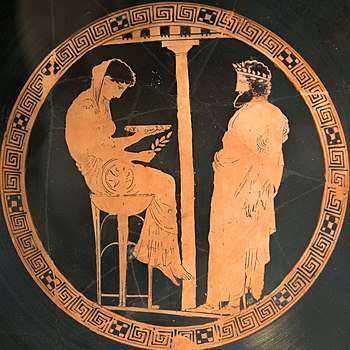
.jpg)
